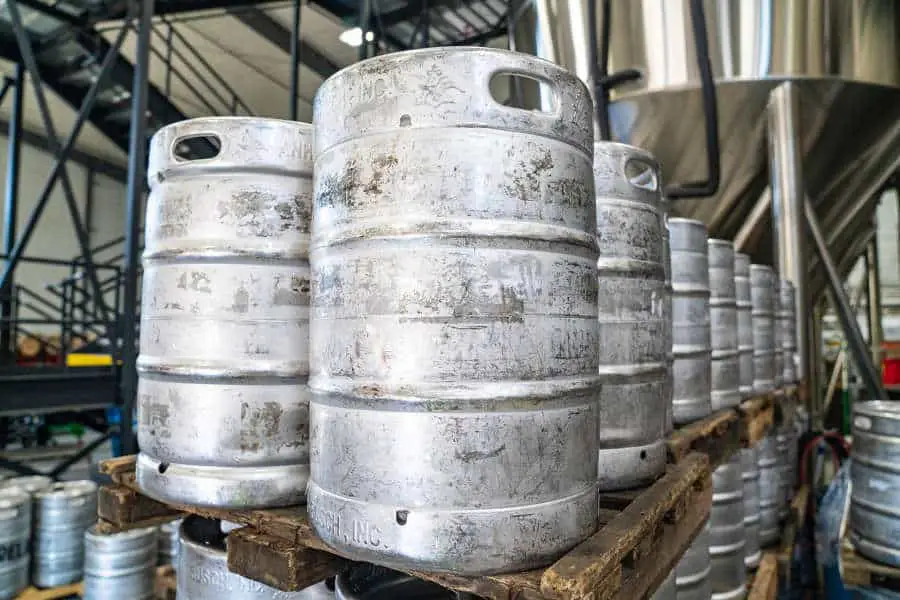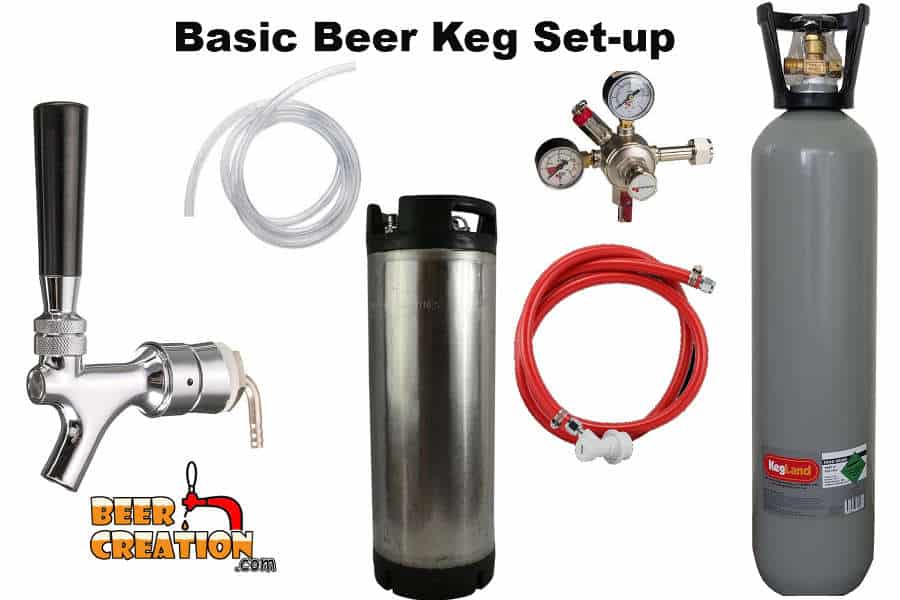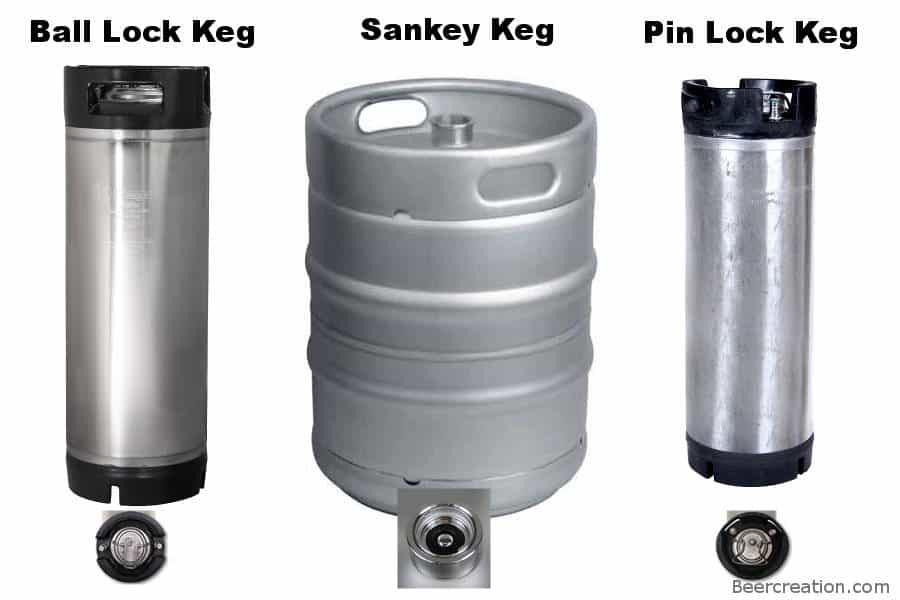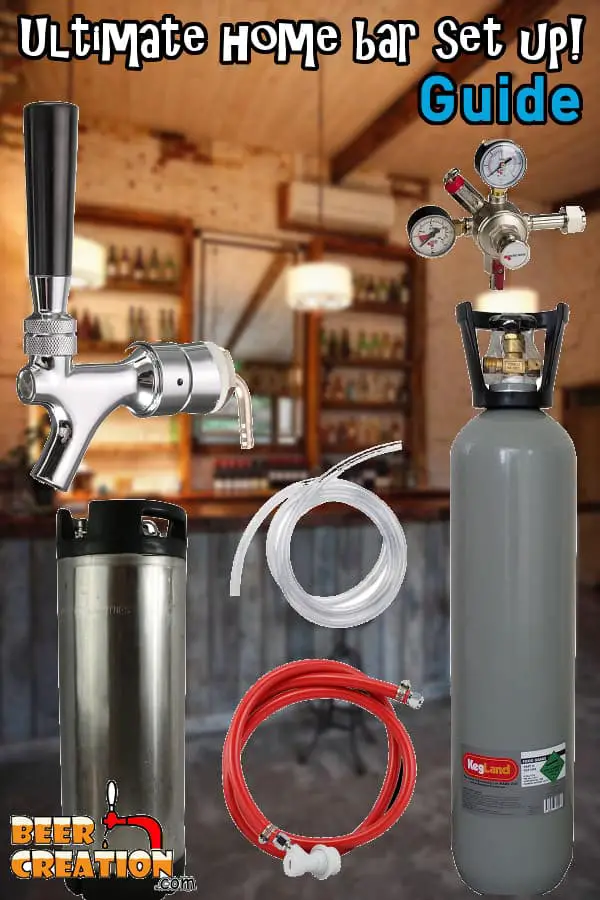As a beer lover of many years and a former barman, I can honestly say there is nothing cooler than working with kegs. Changing ‘a barrel’ or keg is both fun and challenging and it really looks impressive to family and guests. So, why wouldn’t you want to store your beer (especially homemade beer) in a keg?
What will you find in this guide to beer kegs?
- Tips on choosing the best keg for the job
- Tips on the cost of buying and operating kegs
- Tips on how to operate and maintain kegs
- a guide to how kegging affects your beer
- a guide to the storage of your keg at home
I have spent several days researching everything there is to know about beer kegs. I have canvased the forums and Facebook groups and found every expert and user to ask them what they thought and knew about beer kegs. This is what they said…
What is a beer keg and how do they work?

A beer keg, although traditionally made of wood, is now generally made of stainless steel and used for storing beer. Kegs come in all shapes and sizes and can store any type of beer. Unlike beer stored in bottles, kegged beer undergoes a process of forced carbonation which basically means the keg is pressurized with gas (Carbon dioxide) and it is this pressure which keeps the beer from going flat.
When you want to actually get at the beer, you need to ‘tap it’ which means attaching one of two systems to the self-sealing valve so that you can easy serve the beer hidden inside. This honestly quite a skill, especially when changing barrels quickly in a dark pub basement, but is really fun to do!
How do you keg home brew beer?

Once you have purchased your keg and pressurizing equipment, you are ready to rack your homemade beer and fill up that keg. There are a few things to bear in mind before you do that.
Sanitizing your beer keg
As any homebrewer will tell you, the sanitation of beer equipment is essential. Even after you have fermented your beer it is very important to store it in clean containers to avoid its exposure to bacteria.
A bacterial infection, even at this late stage, could really make your beer taste terrible. So, sanitizing your beer keg (even if you cleaned it after a previous use) is the first step to kegging any beer.
Sanitizing Step 1: Disassemble your keg.
The first thing to do is to release the pressure in your keg by pulling the lid relief valve. This will allow any CO2 in the keg to safely exit it so that you won’t injure yourself when removing other parts of the keg.
Next, you want to remove the lid by the handle provided. Sometimes these lids can stick after they have been used if this is the case protect your hand with a cloth or glove and put your weight onto it. It should come away easily enough now.
Most keg designs (Ball lock and Pin lock) will have a liquid and gas post on opposite sides of the keg (check your manufacturer’s instructions for your keg). One will be labeled Out, that’s the liquid post and the other in, that’s the gas post. Normally the gas post will have notches in the bold head and the liquid post will be a smooth bolt. You need to remove these with the help of a crescent wrench or socket wrench.
Sanitizing Step 2: Use a sanitizing solution
Place the lid, both posts and gas post’s short dip tube in a container with a sanitizing solution for about 2 minutes and then allow to air dry. The longer dip tube attached to the liquid post should be placed in the keg shell which is then filled with a sanitizing solution for 2 minutes.
Sanitizing Step 3: Drying and reassembly
Once the keg’s components have been air-dried for several hours, reassemble them in reverse order ready to receive your newly fermented homebrew beer.
Kegging your beer: Pressurizing and racking
Step 1: Checking your gas system
Before you start transferring beer into a keg system, you need to test your CO2 gas system for any leaks. If you skipped this step you could at best lead to flat beer, at worse and in extreme cases, it could lead to death. So be diligent in this next stage.
Attach your CO2 regulator to the gas cylinder ensuring it is tight. The attack and tighten the gas line and disconnect to the regulator. Use an adjustable wrench to do this properly.
In order to test for any leaks, dab each connection with a soapy cloth and get some foam on them. Then open each valve to check for any bubbles on these connections (meaning a gas leak).
Step 2: Siphoning your beer
For best result and to avoid bacterial infections, use an auto-siphon system to rack (transfer) your beer to your keg. Make sure that you sanitize the siphon tube and other components just as you did with your keg.
Make sure that you have your fermenter higher than your keg in order to take advantage of gravity, also elevate your keg enough that your siphon hose will reach the bottom of the keg. This will avoid it oxygenating the beer, which could lead to off-flavors later on.
Remove the stopper and airlock from your fermenter. place the siphon hose into the keg (or attach it to the liquid post) and place the auto-siphon end into your fermenter. Give the auto-siphon system a few pumps to get the beer flowing. remember that a larger gauge siphon hose will transfer beer more quickly than a narrower hose.
As you begin to empty your fermenter be aware of the sediment level and make sure that you don’t transfer this into your keg. Better to lose a pint in the fermenter than have sediment in your keg later. Place the lid on the keg and secure it.
Step 3: Carbonating your beer
During the racking phase you have introduced oxygen into your keg, so the first thing we want to do is to get rid of that.
Hook up your gas line to the ‘In’ side of the keg and introduce some CO2 until you stop hearing the hiss of it entering the keg at which point turn it off. Then pull the lid release valve. You carry out this process a few times to be sure that all the oxygen has been pushed out of the keg by the CO2.
Now we can force carbonate the beer. You want to adjust your carbonating pressure by turning the set screw on the CO2 regulator. Force carbonate the beer to the PSI level instructed by the supplier of your beer recipe. 20 PSI for about 2-3 days is a good estimate for most beers.
For dispensing the beer, shut off the regulator and release pressure in the keg’s headspace with the lid relief valve. Set the shut-off regulator to the dispensing PSI level needed. Reopen the shut-off valve and now adjust the PSI in the keg to around 10-12 PSI for dispensing the beer.
Attach the liquid line to ‘out’ post on the keg and you are ready to pour. If the beer is flat, you just need to force carbonate the beer again for another day or so. If it’s not flat, drink it down!
What maintenance do beer kegs need?
For the average home brewer, keg maintenance will be limited to properly cleaning them after each use. If you are renting kegs from a supplier, they will normally handle the maintenance of their own kegs.
For your own kegs, ensure that you thoroughly clean your kegs after you have emptied them of your favorite beers. Disassemble them and rinse them in a sanitizing solution for at least 30 minutes – 1 hour to really remove any organic build-up inside. Then store them dry and sealed in a cool place out of direct sunlight. Be sure to re-sanitize the keg before further use.
Make sure that you monitor the gas pressure system you use. Always ensure that you use quality materials and check for gas leakage regularly. If you find that your keg isn’t maintaining PSI level required, check all connections for leaks. If none are found, consider covering the entire empty keg in soapy foam and pressuring it, you may have a rare faulty keg with a busted seam.
In all honesty, if you buy a new keg from a reputable store you are unlikely to have many maintenance issues with it even after extended use.
Should I use a manual pump (Bronco pump) on my beer keg?
If you are buying a keg for a big party and plan to drink that thing dry in one night, then there is nothing wrong with using a manual pump. It works by introducing oxygen into the keg and pressurizing it enough to release the beer.
The main issues with this system are that over-pumping can produce a very foamy beer which is hard to pour well and the added air really reduces the shelf life of the beer. But, as I said if this is a big party and you aren’t planning to have any beer the next day, a manual pump is just great. I wouldn’t, however, recommend this for most home-brew projects as the frustration and limited beer life would become very annoying very quickly.
How long will a beer remain pressurized without CO2 turned on?
Sometimes as a homebrewer, you make more beer than you can drink, not the worse crime in the world I know. But, what do you do if you have newly brewed a beer and only have limited kegging equipment? Let’s say you have a kegerator but only space for one or two kegs at a time? Can you disconnect one keg in order to accommodate the newest member of the club? Yes!
If you have successfully racked and carbonated your beer you can remove it from the gas system and store it in a cool place for a number of weeks without fear of it suffering from going flat or becoming oxygenated.
Before removing the keg from the gas it is recommended that you increase the pressure inside to about 30 PSI then turn off your CO2 supply. Over the next few hours monitor the pressure and use the lid relief valve to remove CO2 from the headspace until you reach a PSI level of about 10. Then you can store your beer for a few weeks up to a couple of months. In this time the beer should remain carbonated and perfectly ready to be drunk at any time.
How to change a keg over to another keg in your home bar?
There is nothing quite like having your own bar at home where you can entertain friends and family. But what happens when you go to pour the neighbor a cold glass of the beer you’ve been raving about and all you get is foam?
If you are lucky enough to have another keg which has already been force carbonated (always the case when buying a keg from a beer store) you can simply disconnect your empty keg and reattach the new one, making sure that you turn off the CO2 while swapping them over. Ensure that you purge the first pint or so either through an inbuilt bleeding system or by slowly opening your beer tap and allowing the foamy beer to escape. Make sure you open the tap only a little otherwise you could cover your guests in beer (I actually did this in a full pub on a Saturday night, very embarrassing).
If you are changing from one beer to another type of beer, it would be a good idea to actually sanitize your beer pipes so as not to introduce other flavors into the new beer. Also, it’s a good idea to just do this after each keg is empty to avoid a build-up of nasty bacteria in them.
How long does beer last in a keg after it’s been tapped?
Remember that even stale beer is drinkable and won’t harm you (except maybe your taste buds), but we all want to enjoy fresh tasting beer. So, if the largest kegs can hold up to 100 pints of beer, you’d need to be pretty dedicated in order to finish an entire keg on your own in a few days.
So, how long will that beer stay nice and fresh if you are only enjoying it in moderation? For about 6-8 weeks. If the beer is pasteurized then it will last a lot longer from a minimum of 3 months up to 6 months. If the beer is unpasteurized then it will last for about two months. Most homebrew beer isn’t pasteurized due to the process of making it, so it needs to be stored at least 38°F to avoid bacteria forming in it. Many imported draft beer has been pasteurized and can be stored at room temperature safely without any risk to the quality of the beer.
Different types of kegs for homebrewing

There are three popular keg types which are used in homebrewing setups, the ball lock, the pin lock (both known as Cornelius or ‘corny’ kegs) and the Sankey. The ball lock and pin lock aren’t that too dissimilar but still have some differences that you should be aware of. The Sankey will be most recognizable to anyone who’s worked with commercial beer but is gaining popularity in the amateur beer-making world too. (buy beer from local breweries)
The Ball Lock Keg
Both types of Corny kegs were originally used in the soft drink industry and ball lock kegs were most associated with the Pepsi company. It’s a long skinny style keg and uses a ball lock on its connections, hence the name. The ball lock also comes with a pull ring pressure release valve.
The Pin lock Keg
Pin lock kegs were most associated with the Coca-cola brand and used a pin lock system for their coupling connections. This type of keg is also about 3 inches shorter than a ball lock type and about one inch smaller in diameter. They also don’t have a pull ring relief valve, opting for a fuse type valve. Often pin lock kegs are converted to the ball lock design out of preference for these features.
Both these Corny keg types have separate connection points for the CO2 and liquid but it seems easier to confuse them with each other with the latter design.
The Sankey Keg
The Sankey keg is very different to the other two designs in the fact that it only has one connection point, called the coupler, which allows both CO2 to enter the keg and liquid to exit it. This is what I was most familiar with as a barman, but it is slowly being taken on by many home brewers.
Although the coupler is harder to disassemble in comparison to the Corny keg setups, it does limit the chance of a CO2 leak because it only has one connection.
Other keg types
Another type of keg is known as a growler and is a small transportation keg. It’s not used to store beer for any length of time but is excellent for carrying beer from a favorite brewery back to your home or out for a beer tasting event. Growlers have been used for at least a couple hundred years but are now pressurized vessels used to keep beer for only a day or so before drinking it. (buy beer from local breweries)
How much does a basic kegging system cost?
A basic beer keg system will cost less than $200 -$250 in total. This includes a standard 5-gallon keg, a CO2 gas system and all the accessories needed for carbonating the beer and dispensing it. The average beer brewing starter kit will cost you around $100 (see my full article on the best kits here) and about half that price for just the ingredients needed to produce 5 gallons of beer. (shop for your brewing ingredients on homebrewing.org).
Best Keg to buy for home brewing
Name | Type | Capacity | empty Weight | Ful Weight | Dimensions (inches) | Cost | Buy |
|---|---|---|---|---|---|---|---|
Keg Kit (Keg, CO2, all accessories) | Ball lock | 5 gallon | 25 lbs | 66.7 | 26 x 18 x 10 | $169.95 | Check current price (Amazon) |
Kegco 5 Gallon Commercial Keg | sankey (drop-in D) | 5 gallon | 14.5 lbs | 56.2 lbs | 9.2 x 9.2 x 23.2 | $126.23 | Check current price (Amazon) |
Draft Brewer Single Homebrew Kegging System | ball lock | 5 gallon | 13.05 lbs | 54.75 lbs | 10 x 10 x 36 | $169.99 | Check current price (Amazon) |
5 Gallon Home Brew Keg | ball lock | 5 gallon | 14.11 lbs | 55.81 lbs | 10 x 25 x 9 | $99.99 | Check current price (Amazon) |
Kegco KM5G-RBT 5 Gallon Ball Lock Keg | ball lock | 5 gallon | 10 lbs | 51.7 lbs | 8.5 x 8.5 x 25 | $130.19 | Check current price (Amazon) |
Cornelius Keg | ball lock | 5 gallon | 9.5 lbs | 51.2 lbs | 25 x 9 x 9 | $99.99 | Check current price (Amazon) |
NutriChef Growler | Growler | 64 fl oz | 4.02 lbs | 8.02 lbs | 6.9 x 7.5 x 13.4 | $109.99 | Check current price (Amazon) |
Additional equipment needed for a homebrew keg system
In order to successfully use a keg for storing and serving your beer, you will require some additional equipment. Making sure that all your equipment is compatible with each other is essential, so always deal with reputable suppliers with industry standard products.
CO2 regulator
A CO2 regulator fits onto your CO2 cylinder and allows you to regulate how much gas is released when the system is operating. It’s an essential piece of kit as it will allow you to see how much pressure is in your keg and enable you to raise that pressure (lowering it is achieved with a relief valve on the keg itself).
Beer Tap
Another essential piece of kit is a decent beer tap. Without this, all your efforts would be in vain because you wouldn’t be able to easily pour your beer from the keg.
There are many options for beer taps. You can get a simple beer party pump which most people will be familiar with from college. Alternatively, you can invest in a fixed beer tap on your countertop or on the wall of your garage or basement. Invest in good materials which won’t wear and tear too much after repeated use (come on, let’s not lie to ourselves here!)
Beer line
Probably the cheapest piece of kit in the entire ensemble but also the most important to get right. Don’t skimp on this purchase! Make sure that you get beer lines which are up to food standard otherwise you may get an unpleasant taste in your beer as it passes through a below-par tube. Also, remember to clean your beer lines period to avoid bacteria from building up.
Refrigeration
Although not a must for all beer types, chilling your keg and thus your beer is an advantage for most tasting sessions. You can buy dedicated refrigerators for your set up or simply buy your own second-hand unit and build a kegerator of your own.
Other Beer Kegging Questions:
How to transport a keg without affecting the beer.
At some time in all our lives, we are going to have to leave the man cave (or woman cave) and transport a keg of beer. Whether you are buying a keg for a party or wedding or you are a kind soul who has lovingly brewed beer for someone else. But, moving a keg full of beer can really affect its quality.
Transporting a keg Tips:
- Only transport beer on a cool day or at the coolest time of day to avoid heat from deteriorating your beer
- Carry the beer (with someone else if needed) and don’t roll or drop the keg
- always transport the keg upright where possible to avoid churning up any yeast sediment inside.
- Drive like an old lady so that you don’t slosh that amber nectar around too much. Drive at a steady pace and don’t slam on the breaks
- Chill your beer on arrival. Either use a kegerator or place the keg in a large bath or trashcan full of ice for at least 2 hours before serving.
Can I send a beer keg through the mail?
Yes, this is possible with bigger American package delivery companies but only if you are licensed and if you are sending it to a supplier of beer rather than a consumer. For most home brewers, the answer is going to be no as you won’t have the necessary documents and will be sending it to friends or family. It might be better if you just drink that beer yourself or make a road trip.
What type of gas to use in a keg?
By far the most common gas to use for kegging beer is Carbon Dioxide. However, Nitrogen is also used in many commercial beers. Generally, the effect of using nitrogen is to make the beer very creamy. Think Guinness or John Smith’s Extra Smooth. Carbon Dioxide is used in most lagers and ciders, Stella Artois for example. Most homebrewers will be dealing with CO2 gas cylinders.
How long does a CO2 tank last and how many kegs can it dispense?
For a regular 5 pound cylinder of liquid CO2 gas, you will be able to use it for at least 6 months of normal dispensing usage. This means that you can easily use the same CO2 tank for 15-22 five-gallon kegs. By normal dispensing, I mean purely pouring beer from the keg through your beer tap into your glass at about 10-12 PSI in the keg.
However, if you force carbonate your kegs using the same CO2 cylinder then you will have to replace it every 10-15 kegs. The temperature your CO2 tank is stored at will also affect how long it lasts. Higher temperatures may result in more pressure within the tank whereas lower temperatures can reduce the pressure.






